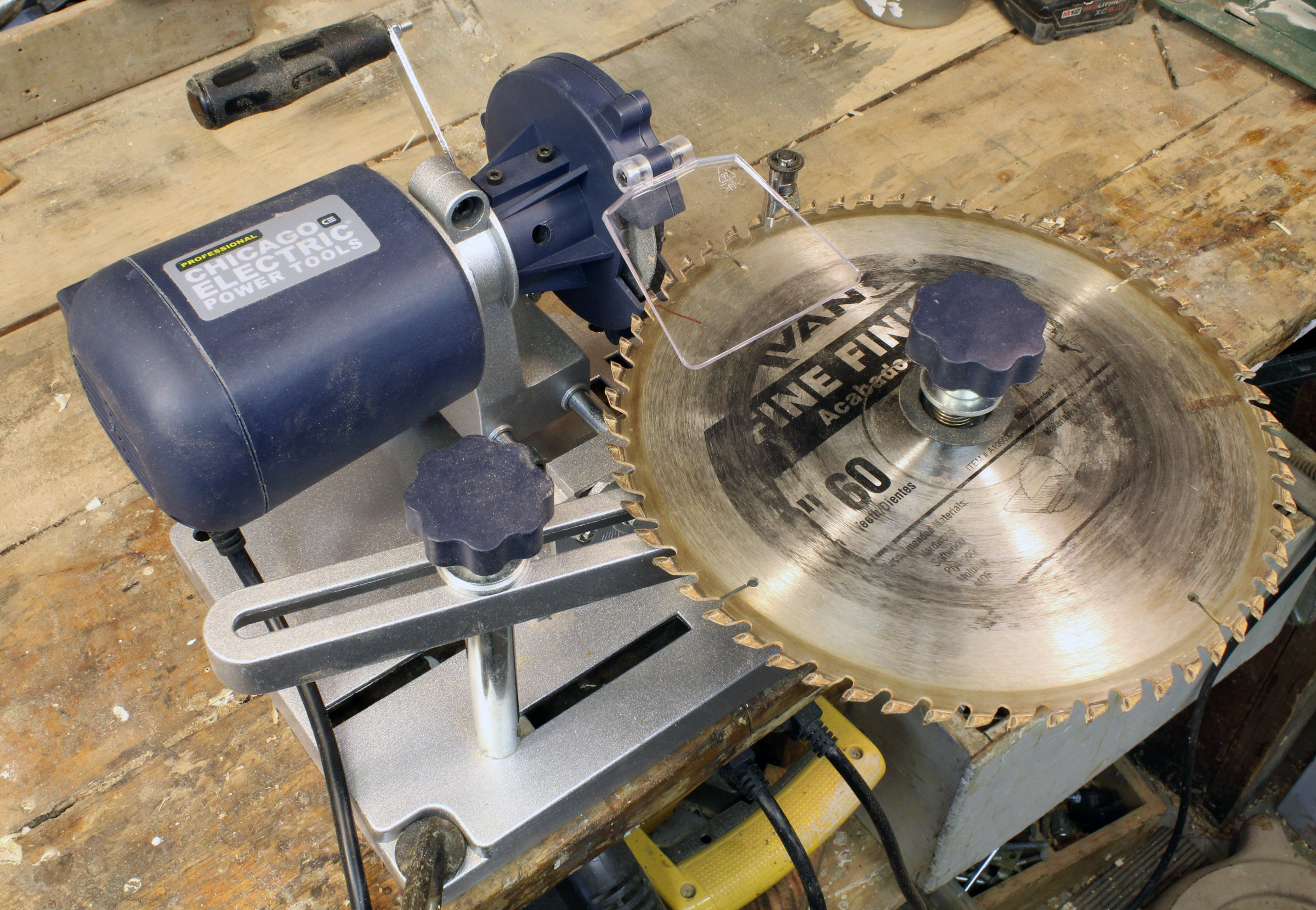Can you sharpen a circular saw blade? Yes, you absolutely can! This guide provides simple DIY tips to sharpen your circular saw blade, saving you money and extending the life of your blades. Learning how to sharpen your own circular saw blade and circular saw blade sharpening is a valuable skill for any woodworker.

Image Source: smallboatsmonthly.com
Why Sharpen a Circular Saw Blade?
A dull circular saw blade doesn’t just make your work harder; it can also be dangerous. Here’s why keeping your blades sharp is crucial:
- Improved Cutting Performance: A sharp blade slices through wood effortlessly, producing clean, smooth cuts.
- Reduced Risk of Kickback: Dull blades require more force, increasing the chances of the saw kicking back, which can cause injury.
- Extended Blade Life: Regular sharpening prevents excessive wear and tear, prolonging the life of your circular saw blade.
- Better Finish Quality: Sharp blades minimize splintering and tear-out, resulting in a professional-looking finish.
- Cost Savings: Sharpening your own blades saves money compared to buying new ones or using a sharpening service for circular saw blades.
Determining if Your Circular Saw Blade Needs Sharpening
How do you know when it’s time to sharpen a circular saw blade? Here are some telltale signs:
- Burning Smell: A burning smell during cutting indicates that the blade is generating excessive heat due to friction.
- Slow Cutting Speed: If the saw struggles to cut through the material, the blade is likely dull.
- Excessive Vibration: A dull blade can cause the saw to vibrate more than usual.
- Splintering or Tear-Out: If the blade produces rough or splintered edges, it’s time for sharpening.
- Visible Damage: Inspect the teeth for chipped, rounded, or missing carbide tips.
Safety First: Preparing to Sharpen
Before you begin any sharpening process, safety is paramount.
- Wear Safety Glasses: Protect your eyes from flying debris.
- Wear Gloves: Protect your hands from sharp blade edges.
- Unplug the Saw: Ensure the saw is disconnected from the power source.
- Secure the Blade: Clamp the blade firmly in a vise to prevent movement during sharpening.
- Work in a Well-Lit Area: Good lighting is essential for precision and safety.
Circular Saw Blade Sharpening Tools
Having the right tools is essential for effective sharpening. Here are some circular saw blade sharpening tools you can use:
- File: A specialized saw file, also known as a mill file, is specifically designed for sharpening saw teeth.
- Vise: A sturdy vise is needed to hold the blade securely.
- Magnifying Glass: A magnifying glass helps inspect the teeth for damage and ensures accurate filing.
- Bench Grinder (Optional): A bench grinder can be used for faster sharpening, but requires more skill.
- Diamond Sharpening Stone (Optional): This can be used for fine-tuning the edges of the teeth.
- Tooth Setter (Optional): For setting the teeth of some blades (not always needed).
- Marker: To mark the starting point.
Table: Comparing Sharpening Tools
| Tool | Pros | Cons | Best For |
|---|---|---|---|
| File | Inexpensive, easy to control, precise | Slower than power tools, requires more manual effort | Small jobs, fine-tuning, maintaining tooth angle. |
| Bench Grinder | Fast, efficient for removing material | Can easily overheat the blade, requires skill to avoid damage | Heavily damaged blades, quickly restoring sharpness to many blades. |
| Diamond Sharpening Stone | Provides a very fine edge, good for carbide teeth, less aggressive than files | More expensive than files, not ideal for heavily damaged blades | Honing already sharp teeth, carbide-tipped blades. |
| Tooth Setter | Maintains correct tooth offset, critical for cutting performance | Requires experience to use correctly, not always necessary for all blades | Blades where teeth have been bent or damaged, maintaining original offset. |
Sharpening Circular Saw Blade By Hand: A Step-by-Step Guide
Here’s a simple guide to sharpening a circular saw blade by hand:
- Secure the Blade: Place the blade in the vise, exposing only a few teeth at a time.
- Identify the Tooth Angle: Examine the blade to determine the angle of the teeth. This is crucial for maintaining the correct cutting geometry.
- File Each Tooth: Hold the file at the same angle as the tooth bevel. Gently file each tooth using smooth, consistent strokes. File from the back of the tooth towards the point. Remove only a small amount of material with each stroke.
- Maintain Consistency: Ensure that each tooth is filed equally to maintain balance.
- Rotate the Blade: Rotate the blade in the vise to expose the next set of teeth, and repeat the filing process.
- Check Your Work: Use a magnifying glass to inspect the teeth for sharpness and consistency.
- Deburr (Optional): Use a fine sharpening stone to remove any burrs from the teeth.
Tips for Sharpening by Hand
- Use Light Pressure: Avoid applying excessive pressure, which can damage the teeth.
- Maintain the Angle: Keep the file at the correct angle to preserve the tooth geometry.
- Count Your Strokes: File each tooth with the same number of strokes to maintain consistency.
- Keep the File Clean: Use a wire brush to clean the file regularly.
- Take Your Time: Sharpening by hand requires patience and attention to detail.
Using a Bench Grinder for Circular Saw Blade Sharpening
A bench grinder can speed up the sharpening process, but it requires more skill and caution.
- Mount the Grinding Wheel: Use a fine-grit grinding wheel specifically designed for sharpening blades.
- Adjust the Tool Rest: Position the tool rest so that it supports the blade at the correct angle.
- Wear Safety Gear: Always wear safety glasses and a dust mask when using a bench grinder.
- Sharpen Each Tooth: Gently touch each tooth to the grinding wheel, using light pressure. Avoid overheating the blade.
- Cool the Blade: Dip the blade in water frequently to prevent overheating, which can damage the temper of the steel.
- Inspect Your Work: Use a magnifying glass to check the teeth for sharpness and consistency.
Cautions When Using a Bench Grinder
- Overheating: Overheating can damage the blade and reduce its lifespan.
- Incorrect Angle: Sharpening at the wrong angle can ruin the blade’s cutting performance.
- Uneven Sharpening: Uneven sharpening can cause the blade to wobble and produce poor cuts.
Alternative: Sharpening Service for Circular Saw Blades
If you’re uncomfortable sharpening your own blades or lack the necessary tools, consider using a professional sharpening service for circular saw blades.
Benefits of Using a Sharpening Service:
- Professional Results: Sharpening services have specialized equipment and expertise to achieve optimal sharpness.
- Time Savings: Outsourcing the job saves you time and effort.
- Convenience: Many services offer pickup and delivery options.
Drawbacks of Using a Sharpening Service:
- Cost: Sharpening services can be more expensive than DIY sharpening.
- Turnaround Time: You may have to wait several days to get your blades back.
Circular Saw Blade Maintenance: Extending Blade Life
Regular circular saw blade maintenance is crucial for extending blade life and ensuring optimal performance.
- Clean the Blade Regularly: Remove pitch and resin buildup with a blade cleaner.
- Store the Blade Properly: Store the blade in a dry place to prevent rust.
- Inspect the Blade Before Each Use: Check for damage or dullness.
- Use the Correct Blade for the Material: Using the wrong blade can cause excessive wear and tear.
- Avoid Cutting Nails or Screws: These can damage the blade teeth.
Best Way To Sharpen Circular Saw Blade: A Summary
The best way to sharpen a circular saw blade depends on your skill level, available tools, and the condition of the blade. Sharpening circular saw blades at home is a good option if you have the patience and tools.
- For light touch-ups: A file or diamond sharpening stone is ideal.
- For heavily damaged blades: A bench grinder can be used with caution.
- For convenience and professional results: A sharpening service is a good choice.
Fathoming Tooth Geometry
The teeth on a circular saw blade aren’t just simple points; they have carefully engineered angles that affect how they cut. The key angles to know are:
- Top Bevel Angle: This is the angle on the top of the tooth that slices through the wood.
- Face Angle: This is the angle on the front of the tooth that clears the chips away.
- Relief Angle: This angle provides clearance behind the cutting edge.
Maintaining these angles during sharpening is critical. If you change the angles, the blade won’t cut properly. It might grab, bind, or produce rough cuts. If you’re unsure about the correct angles, consult the blade manufacturer’s specifications.
Table: Common Tooth Geometry Terms
| Term | Description | Importance |
|---|---|---|
| Top Bevel | Angle on the top edge of the tooth that does the actual cutting. | Affects the smoothness and aggressiveness of the cut. |
| Face Angle | Angle on the front of the tooth that helps clear chips. | Prevents the blade from binding and ensures efficient cutting. |
| Relief Angle | Angle that provides clearance behind the cutting edge. | Reduces friction and prevents the blade from overheating. |
| Gullet | The space between the teeth that allows for chip removal. | A deep gullet allows for faster cutting, especially in thicker materials. |
| Rake Angle | The angle of the tooth relative to the center of the blade. | Determines how aggressively the blade bites into the material. |
| Set | The amount that each tooth is bent slightly outward from the blade’s center line. | Provides clearance for the blade to pass through the cut without binding. |
Deciphering Carbide vs. Steel Blades
Most circular saw blades are made of either steel or have carbide-tipped teeth. Knowing the difference is important for sharpening.
- Steel Blades: These are less expensive but dull more quickly. They can be sharpened multiple times with a file.
- Carbide-Tipped Blades: These are more expensive but stay sharp much longer. They require specialized sharpening tools like diamond files or grinding wheels.
Trying to sharpen a carbide-tipped blade with a regular file will be ineffective and can damage the file. Always use the correct sharpening tool for the blade material.
Table: Comparing Steel and Carbide Blades
| Feature | Steel Blades | Carbide-Tipped Blades |
|---|---|---|
| Material | High-speed steel | Steel body with carbide-tipped teeth |
| Cost | Lower | Higher |
| Sharpness | Dulls faster | Stays sharp longer |
| Sharpening | Easier to sharpen with a file | Requires diamond tools or professional sharpening |
| Best For | General-purpose cutting, softer woods | Hardwoods, abrasive materials, long-term use |
| Life Expectancy | Shorter | Longer |
FAQ: Sharpening Circular Saw Blades
- What is the best way to sharpen a circular saw blade? The best way depends on your skill and tools. Hand filing is precise and affordable. A bench grinder is faster but requires more skill. Professional sharpening services offer convenience and expertise.
- Can I use a regular file to sharpen a carbide blade? No, you need a diamond file or a grinding wheel.
- How often should I sharpen my circular saw blade? When you notice signs of dullness, such as burning, slow cutting, or splintering.
- Who is best suited for sharpening their own blades? People who are comfortable working with tools, have some experience, and are willing to invest time and effort.
- What angle should I use when sharpening a circular saw blade? Use the same angle as the original tooth bevel. Check the manufacturer’s specs if you are unsure.
- Can I sharpen a circular saw blade while it’s on the saw? No, always remove the blade and secure it in a vise before sharpening.
By following these tips, you can effectively sharpen your circular saw blades and keep them in top condition for years to come. Regular sharpening and maintenance will save you money, improve your cutting performance, and enhance your safety.

Hi, I’m Tom Scalisi, and welcome to The Saw Blog! I started this blog to share my hands-on experience and insights about woodworking tools—especially saws and saw blades. Over the years, I’ve had the chance to work with a wide range of tools, and I’m here to help both professionals and hobbyists make informed decisions when it comes to selecting and using their equipment. Whether you’re looking for in-depth reviews, tips, or just advice on how to get the best performance out of your tools, you’ll find it here. I’m excited to be part of your woodworking journey!
